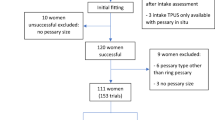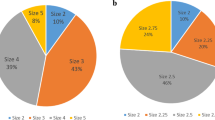Abstract
Introduction and hypothesis
This study explored whether the optimal pessary type and size can be predicted using the specific pelvic organ prolapse quantification system (POP-Q) measurements in women with pelvic organ prolapse in a fitting trial.
Methods
We conducted a prospective study in women who had undergone pessary fitting. A total of 78 patients with stage II, III or IV symptomatic pelvic organ prolapse completed a detailed history. Data were analysed using nonparametric tests, continuity correction chi-squared tests and multivariate logistic regression.
Results
Differences in total vaginal length (TVL; p < 0.01) and vaginal introitus width/TVL ratio (p = 0.012) were observed between patients with and without a history of hysterectomy. Patients with a history of hysterectomy and patients with a larger vaginal introitus had more success with the Gellhorn pessary than with the ring pessary with support (p = 0.005 and p = 0.01, respectively). Factors determining the size of the ring pessary with support were the genital hiatus (GH) width (p = 0.044), TVL (p = 0.011), vaginal introitus width (p < 0.001), and vaginal introitus width/TVL ratio (p = 0.025). Factors determining the size of the Gellhorn pessary were the GH width (p = 0.025), GH width/TVL ratio (p = 0.013), vaginal introitus width (p = 0.003), vaginal introitus width/TVL ratio (p = 0.001), stage of apical prolapse (p = 0.006) and stage of posterior prolapse (p = 0.003).
Conclusions
Patients with a history of hysterectomy or with a larger vaginal introitus were more likely to achieve success with the Gellhorn pessary. The GH width and the vaginal introitus width influenced the size of both pessaries chosen. The TVL was predictive of the optimal size of the ring pessary with support but was not predictive of the optimal size of the Gellhorn pessary. Finally, the size of the Gellhorn pessary was associated with POP stage.

Similar content being viewed by others
References
DeLancey JO (2005) The hidden epidemic of pelvic floor dysfunction: achievable goals for improved prevention and treatment. Am J Obstet Gynecol 192:1488–1495. doi:10.1016/j.ajog.2005.02.028
Nygaard I, Barber MD, Burgio KL, Kenton K, Meikle S, Schaffer J, Spimo C, Whitehead WE, Wu J, Brody DJ (2008) Prevalence of symptomatic pelvic floor disorders in US women. JAMA 300:1311–1316. doi:10.1001/jama.300.11.1311
Cundiff GW, Weidner AC, Visco AG, Bump RC, Addison WA (2000) A survey of pessary use by members of the American Urogynecologic Society. Obstet Gynecol 95:931–935. doi:10.1016/S0029-7844(00)00788-2
Atnip S, O’Dell K (2012) Vaginal support pessaries: indications for use and fitting strategies. Urol Nurs 32:114–124. doi:10.1016/j.juro.2012.12.068
Bump RC, Mattiasson A, Bo K, Brubaker LP, DeLancey JOL, Klarskov P, Shull BL, Smith AR (1996) The standardization of terminology of female pelvic organ prolapse and pelvic floor dysfunction. Am J Obstet Gynecol 175:10–17. doi:10.1016/S0002-9378(96)70243-0
Clemons JL, Aguilar VC, Tillinghast TA, Jackson ND, Myers DL (2004) Risk factors associated with an unsuccessful pessary fitting trial in women with pelvic organ prolapse. Am J Obstet Gynecol 190:345–350. doi:10.1016/j.ajog.2003.08.034
Weber AM, Richter HE (2005) Pelvic organ prolapse. Obstet Gynecol 106:615–634. doi:10.1097/01.AOG.0000175832.13266.bb
Clemons JL, Aguilar VC, Tillinghast TA, Jackson ND, Myers DL (2014) Patient satisfaction and changes in prolapse and urinary symptoms in women who were fitted successfully with a pessary for pelvic organ prolapse. Am J Obstet Gynecol 190:1025–1029. doi:10.1016/j.ajog.2003.10.711
Nager CW, Richter HE, Nygaard I, Paraiso MF, Wu JM, Kenton K, Atnip SD, Spino C (2009) Incontinence pessaries: size, POPQ measures, and successful fitting. Int Urogynecol J Pelvic Floor Dysfunct 20:1023–1028. doi:10.1007/s00192-009-0866-1
Maito JM, Quam ZA, Craig E, Danner KA, Rogers RG (2006) Predictors of successful pessary fitting and continued use in a nurse-midwifery pessary clinic. J Midwifery Womens Health 51:78–84. doi:10.1016/j.jmwh.2005.09.003
Terry C, Mutone MF, Hale DS, Benson JT (2005) Factors which influence the short-term success of pessary management of pelvic organ prolapse. Am J Obstet Gynecol 93:89–94. doi:10.1016/j.ajog.2004.12.012
Fernando RJ, Sultan AH, Thakar R, Shah SM, Jones PW (2006) Effect of vaginal pessaries on symptoms associated with pelvic organ prolapse. Obstet Gynecol 108:93–99. doi:10.1097/01.AOG.0000222903.38684.cc
Acknowledgments
We thank all the patients for agreeing to participate in the study. We would like to thank Xing-xing Zhang for entering the data.
Author information
Authors and Affiliations
Corresponding author
Ethics declarations
Conflicts of interest
None.
Additional information
This study received financial support from the Chinese Government under the 5-year National Project (number 2014BAI05B02). Chinese Clinical Trial Registry: ChiCTR-OOC-15005930
Rights and permissions
About this article
Cite this article
Ding, J., Song, Xc., Deng, M. et al. Which factors should be considered in choosing pessary type and size for pelvic organ prolapse patients in a fitting trial?. Int Urogynecol J 27, 1867–1871 (2016). https://doi.org/10.1007/s00192-016-3051-3
Received:
Accepted:
Published:
Issue Date:
DOI: https://doi.org/10.1007/s00192-016-3051-3




